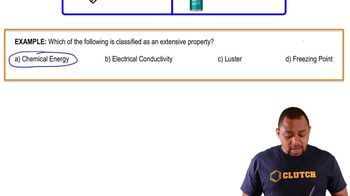Silicon is the fundamental component of integrated circuits. Si has the same structure as diamond. (b) Silicon readily reacts to form silicon dioxide, SiO2, which is quite hard and is insoluble in water. Is SiO2 most likely a molecular, metallic, ionic, or covalent-network solid?
Ch.12 - Solids and Modern Materials
Chapter 12, Problem 14a
Which type (or types) of crystalline solid is characterized by each of the following? (a) High mobility of electrons throughout the solid;

Verified Solution
Video duration:
3mWas this helpful?
Key Concepts
Here are the essential concepts you must grasp in order to answer the question correctly.
Crystalline Solids
Crystalline solids are materials whose constituents, such as atoms or molecules, are arranged in a highly ordered microscopic structure, forming a crystal lattice that extends in all directions. This ordered arrangement gives rise to distinct physical properties, including specific melting points and anisotropic behavior, where properties vary based on direction within the crystal.
Recommended video:
Guided course

Crystalline Solids Structure
Electrical Conductivity
Electrical conductivity refers to the ability of a material to conduct electric current. In solids, this property is largely determined by the presence of free-moving charge carriers, such as electrons. Materials with high electrical conductivity, like metals, allow electrons to move freely, facilitating the flow of electricity throughout the solid.
Recommended video:
Guided course

Extensive Property Example
Types of Crystalline Solids
Crystalline solids can be categorized into different types based on their bonding and structure, including ionic, covalent, metallic, and molecular solids. Metallic solids, characterized by a 'sea of electrons' that allows for high mobility of electrons, are particularly noted for their excellent electrical conductivity, distinguishing them from other types of crystalline solids.
Recommended video:
Guided course

Crystalline Solids Structure
Related Practice
Textbook Question
929
views
Textbook Question
What kinds of attractive forces exist between particles (atoms, molecules, or ions) in (a) molecular crystals?
1166
views
Textbook Question
What kinds of attractive forces exist between particles (atoms, molecules, or ions) in (d) and metallic crystals?
519
views
Textbook Question
Which type (or types) of crystalline solid is characterized by each of the following? (b) softness, relatively low melting point;
781
views
Textbook Question
Which type (or types) of crystalline solid is characterized by each of the following? (c) high melting point and poor electrical conductivity;
483
views
Textbook Question
Which type (or types) of crystalline solid is characterized by each of the following? (d) network of covalent bonds.
710
views
